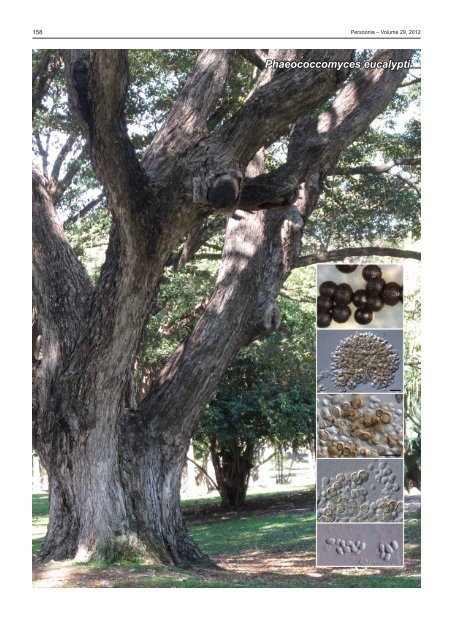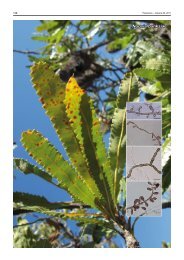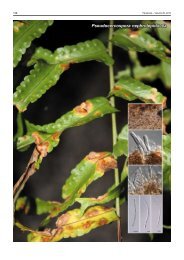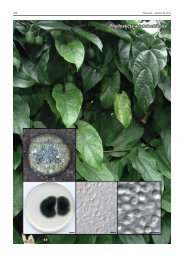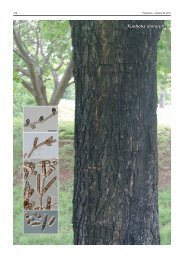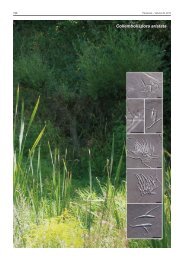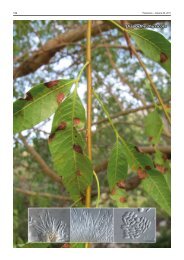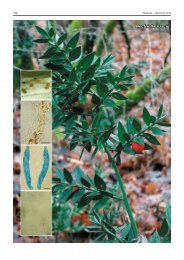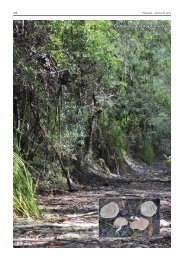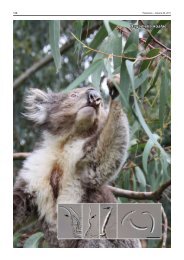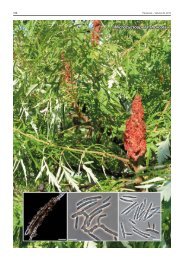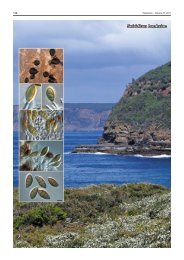Phaeococcomyces eucalypti - Fungal Planet
Phaeococcomyces eucalypti - Fungal Planet
Phaeococcomyces eucalypti - Fungal Planet
Create successful ePaper yourself
Turn your PDF publications into a flip-book with our unique Google optimized e-Paper software.
158 Persoonia – Volume 29, 2012<br />
<strong>Phaeococcomyces</strong> <strong>eucalypti</strong>
<strong>Fungal</strong> <strong>Planet</strong> description sheets<br />
159<br />
<strong>Fungal</strong> <strong>Planet</strong> 133 – 20 December 2012<br />
<strong>Phaeococcomyces</strong> <strong>eucalypti</strong> Crous & R.G. Shivas, sp. nov.<br />
Etymology. Named after the host genus from which it was isolated, Eucalyptus.<br />
Colonies lacking mycelium but consisting of a globular mass<br />
of chlamydospore-like cells; cells aseptate, brown (hyaline<br />
when young), 4–8 µm diam, verruculose, covered in mucus,<br />
globose, thick-walled, remaining attached to one another<br />
through younger end cells at colony margin, which detach<br />
during slide preparation; ellipsoid to globose, hyaline, thickwalled,<br />
covered in mucus, finely verruculose, 3–5 × 2.5–5<br />
µm. Colonies dense, with cells remaining attached on malt<br />
extract agar (MEA), potato-dextrose agar (PDA) and synthetic<br />
nutrient-poor agar (SNA), but on oatmeal agar (OA) colonies<br />
form profuse amounts of mucous and appear looser with cells<br />
forming smaller clusters, and many conidia separate from one<br />
another; conidia also darker brown, and have a thicker wall<br />
and are more verruculose than on other media.<br />
Culture characteristics — (in the dark, 25 °C after 3 wk):<br />
Colonies erumpent, spreading, surface folded, lacking aerial<br />
mycelium, and margins with lobate, irregular margins, reaching<br />
25 mm diam. On MEA, PDA and OA, iron-grey, slimy.<br />
Typus. Australia, Queensland, Anderson Park Botanic Garden, Townsville,<br />
S19°17'28.5" E146°47'13.5", on leaf litter of Eucalyptus sp., together<br />
with ascomata of Thyriopsis sphaerospora, 5 Aug. 2009, P.W. Crous, holo -<br />
type CBS H-21091, cultures ex-type CPC 17606 = CBS 132526, ITS sequence<br />
GenBank KC005769, LSU sequence GenBank KC005791, Myco-<br />
Bank MB801769.<br />
Notes — <strong>Phaeococcomyces</strong> <strong>eucalypti</strong> was isolated while<br />
trying to culture Thyriopsis sphaerospora, a foliar leaf pathogen<br />
of eucalypts that is known from South Africa, South<br />
America (Brazil, Chile) (Park et al. 2000) and Australia. Ascospores<br />
of T. sphaerospora germinate (on MEA and PDA), but<br />
die soon afterwards, which is probably due to its biotrophic<br />
growth habit. Colonies of <strong>Phaeococcomyces</strong> <strong>eucalypti</strong> started<br />
growing from an ascoma with a portion of host tissue that was<br />
plated onto malt extract agar. The logical inference that P. <strong>eucalypti</strong><br />
represents the yeast phase of T. sphaerospora, is highly<br />
unlikely, as T. sphaerospora appears to be an obligate pathogen,<br />
with ascomata occurring on green, healthy leaf tissue.<br />
<strong>Phaeococcomyces</strong> <strong>eucalypti</strong> clusters among unidentified species<br />
of Dothideomycetes (rock fungi), and is allied to P. nigricans,<br />
although it has smaller conidia (de Hoog 1977).<br />
Based on a megablast search of NCBIs GenBank nucleotide<br />
database, only more distant hits were obtained using the ITS<br />
sequence, e.g. with Umbilicaria rigida (GenBank AF096212;<br />
Identities = 457/533 (86 %), Gaps = 35/533 (7 %)), Endoconidioma<br />
populi (GenBank AY604526; Identities = 454/537<br />
(85 %), Gaps = 33/537 (6 %)) and <strong>Phaeococcomyces</strong> nigricans<br />
(GenBank AY843154; Identities = 432/509 (85 %), Gaps<br />
= 18/509 (4 %)). Closest hits using the LSU sequence had<br />
highest similarity to ‘Dothideomycetes sp. TRN 452’ (Gen-<br />
Bank GU323985; Identities = 805/812 (99 %), Gaps = 0/812<br />
(0 %)), ‘Dothideomycetes sp. TRN 456’ (GenBank GU323986;<br />
Identities = 788/812 (97 %), Gaps = 0/812 (0 %)) and <strong>Phaeococcomyces</strong><br />
nigricans (GenBank AF050278; Identities = 830/<br />
860 (97 %), Gaps = 2/860 (0 %)).<br />
Colour illustrations. Giant Eucalyptus tree in Anderson Park Botanic<br />
Garden, Townsville; colonies on PDA; colony sporulating in culture, forming<br />
brown melanised cells, and small, ellipsoid, hyaline conidia. Scale bars =<br />
10 µm.<br />
Pedro W. Crous & Johannes Z. Groenewald, CBS-KNAW <strong>Fungal</strong> Biodiversity Centre, P.O. Box 85167, 3508 AD Utrecht, The Netherlands;<br />
e-mail: p.crous@cbs.knaw.nl & e.groenewald@cbs.knaw.nl<br />
Roger G. Shivas, Biosecurity Queensland, Ecosciences Precinct, Level 2C East, GPO Box 267, Brisbane 4001, Queensland, Australia;<br />
e-mail: roger.shivas@deedi.qld.gov.au<br />
© 2012 Nationaal Herbarium Nederland & Centraalbureau voor Schimmelcultures


